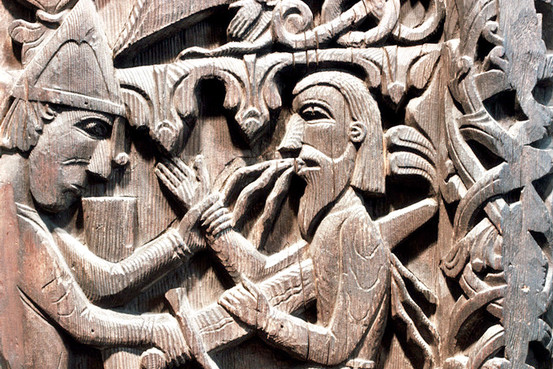Reconstructing the Norn Language from Old Norse
by Michael B. Putnam
 The Orkney and Shetland islands of Scotland were at one time
colonized by Vikings and belonged firmly within the field of
Scandinavian cultural influence. During this time the people of these
archipelagos spoke a unique language known as Norn which evolved from
the Old Norse language. Norn went extinct under the influence of Scots
English some time after Scottish annexation of the islands, and the
majority of the language was lost, save for a handful of remembered
words and one ballad comprising thirty-five stanzas. Using this ballad
and its Old Norse translation, this paper attempts to map the sound
changes that resulted in the emergence of the Norn language.
Norn is a functionally extinct language that was spoken in the
now-Scottish areas of Shetland and Orkney around the ninth century until
the late eighteenth or early nineteenth century (for dating cf. Barns
(2010), Knooihuizen (2008), and Millar (2010)). However, the term Norn
is somewhat confusing in its implementation as Barnes points out:
The Orkney and Shetland islands of Scotland were at one time
colonized by Vikings and belonged firmly within the field of
Scandinavian cultural influence. During this time the people of these
archipelagos spoke a unique language known as Norn which evolved from
the Old Norse language. Norn went extinct under the influence of Scots
English some time after Scottish annexation of the islands, and the
majority of the language was lost, save for a handful of remembered
words and one ballad comprising thirty-five stanzas. Using this ballad
and its Old Norse translation, this paper attempts to map the sound
changes that resulted in the emergence of the Norn language.
Norn is a functionally extinct language that was spoken in the
now-Scottish areas of Shetland and Orkney around the ninth century until
the late eighteenth or early nineteenth century (for dating cf. Barns
(2010), Knooihuizen (2008), and Millar (2010)). However, the term Norn
is somewhat confusing in its implementation as Barnes points out:To some the term denotes any piece of Scandinavian language material emanating from Scotland or, more narrowly, the Northern Isles – including medieval runic inscriptions and roman-alphabet documents. To others Norn means only the spoken Scandinavian of Orkney and Shetland and written records of such speech…For my part I would restrict ‘Norn to mean ‘the distinctive form of Scandinavian [Norse] speech that developed on the Scottish mainland, in the Hebrides, and in Orkney and Shetland’. (Barnes 2010, 27)
Accepting this definition, we find the linguistic “parent” of Norn is the language we today know as Old West Norse, a language once spoken throughout the North Sea Region from Norway to Iceland. Old Norse came to the Northern Isles via Viking raiders in the eighth century and its standing was made permanent with the annexation of Orkney and Shetland by King Harold Fairhair of Norway in 872 (Anderson 1873). By 1549, Norn had emerged as a unique language from its Nordic parent and could be identified as the norn leid or Norn speech (Barnes 2010, 28). This paper will investigate the linguistic morphological and grammatical changes which took place during the shift from Old Norse to Norn.

No comments:
Post a Comment